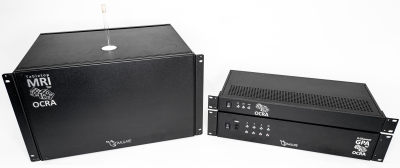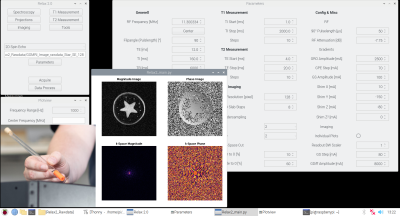OCRA Tabletop MRI System
Marcus Prier1
1Otto-von-Guericke University Magdeburg, Magdeburg, Germany
1Otto-von-Guericke University Magdeburg, Magdeburg, Germany
Synopsis
MRI machines are difficult to access for research and training purposes. The open-source Tabletop MRI developed by the Otto-von-Guericke University employees and students based on the idea of the Martinos Tabletop MRI and the OCRA project is inexpensive to purchase and allows teaching on state of the art MRI hard- and software. This benchtop device allows for the measurement of test-tube-sized samples with the physics of a clinical MRI machine.
MRI
machines are difficult to access for research and training purposes. The
purchase and maintenance of MRI devices is extremely expensive, which is why
universities and university hospitals only have a limited number of devices.
The existing devices are continuously occupied by patient care and are only
available for research and training purposes in very rare exceptional cases. On
the other hand, the open-source Tabletop MRI developed by the Otto-von-Guericke
University employees and students is inexpensive to purchase and requires no
maintenance. This benchtop device allows for the measurement of test-tube-sized
samples with the physics of a clinical MRI machine.
The OCRA
Tabletop MRI was born from the idea of the Martinos Center in Boston (Harvard
Medical School, MIT) [1] and the OCRA (Open-source Console for Real-time
Acquisition) [2] project initiated by Thomas Witzel. Through a cooperation, a fully
functional mini MRT system was developed at the STIMULATE research campus of the OvGU which combines both projects.
The first prototype could be built after a development time of only 2 years
thanks to the extensive equipment of our ego.-Incubator FLEXtronic electronics makerspace [3].
The
tabletop system is identical in construction to a modern clinical MRT, which is
used to examine patients. The core element is a neodymium permanent magnet in a
special iron yoke construction, which provides a homogeneous 0.26T magnetic
field. The complete RF electronics [4] and gradient coils are located as rack
modules magnet yoke. The aluminium housing protects against external
interference and enables safe working. RF and gradient electronics are
controlled using the OCRA console, based on a Red Pitaya microcontroller and a
four 18-bit DACs board, called OCRA1 [5], for generating the analog gradient
signals. A 4-channel 600 Watt gradient amplifier [6] is used to amplify the
gradient signals. The control is taken over by the OCRA software with an
intuitive and customizable graphical user interface based on PyQT and Python. With the OCRA Tabletop MRT, spectroscopy, relaxometry and MR imaging can be
performed on test tube-sized samples with a diameter of up to 15 millimeters.
The system
creates an open source test environment for commercially available MRI
components and enables cost-effective teaching for students on a real, fully
digital MRI. In addition, there is the potential to carry out chemical analyzes
for various purposes.
Acknowledgements
No acknowledgement found.References
- https://tabletop.martinos.org/index.php?title=Main_Page
- https://openmri.github.io/ocra/
- https://www.tugz.ovgu.de/Flextronic.html
- https://zeugmatographix.org/ocra/2021/09/30/transmit-receive-switch-for-the-ocra-tabletop-mri-system/
- https://zeugmatographix.org/ocra/2020/11/27/ocra1-spi-controlled-4-channel-18bit-dac-and-rf-attenutator/
- https://zeugmatographix.org/ocra/2021/12/15/small-scale-600w-gradient-power-amplifier/
Figures

OCRA Tabletop MRI System with the
magnet on the left hand side and the OCRA console and 4 channel 600W gradient
power amplifier on the right hand side.

Our
self-programmed PyQT “Relax” graphical user interface using OCRA. The 256x256
pixel image shows a 10mm test-tube sample with a 3D printed phantom.